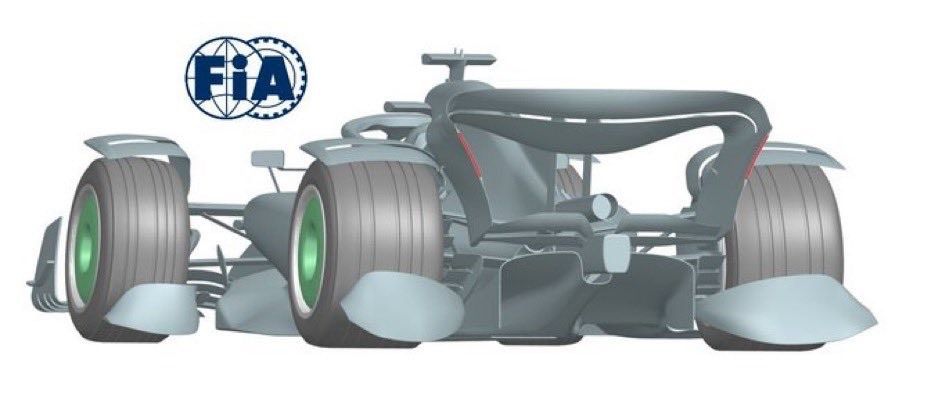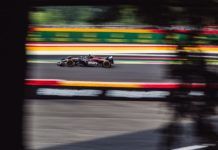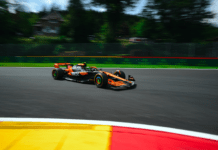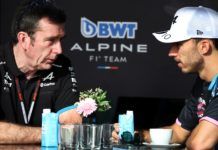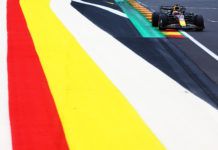The mudguards tested by Pirelli at Silverstone for wet weather running needs more work as F1 and FIA try to fix the spray problem.
Following the F1 British GP, Pirelli not only ran tyres without blankets but also tested the proposed mudguards which the FIA planning to bring in to reduce spray levels in wet races. Mercedes and McLaren were the ones who ran them at Silverstone.
Not much details were shared of the same but Mercedes’ Andrew Shovlin agreed that there is still work to be done as the spray is not limited just to the tyres. The spray also comes from the diffuser area which has to be looked at as well.
“I mean, there’s more work to do on them, but it’s a problem that it would be useful to have a solution for, because I think the teams, and certainly the fans, hate it if a race can’t go ahead because the conditions are too difficult,” said Shovlin. “They’re not ready to be moved into production and regulation at the moment.
“So there’s definitely work to do. They do improve the spray that you get from the tyres, but you still get a lot coming from the diffuser, in the way that the rear wing’s pulling it up. That’s all very powerful. But you know, interesting first steps and we’re providing the car and some bits to do that development.
“It’s the FIA’s project to decide where that goes next and what happens in the future.” Aside the mudguards run, Pirelli once again tested F1 tyres without the blanket, the decision of which was taken at Spa-Francorchamps that it won’t happen in 2024.
“I think the challenge of the dries is a lot bigger than the wets and you can definitely run race weekends without blankets because you could do it next week if you wanted to do that,” said Shovlin. “The question is, does it improve the racing, do you have a better show?
“And whilst you can do it in testing, the grip comes halfway around the lap and then it’s relatively normal for the drivers from there on. There are scenarios that you can’t really do in testing like a wet to dry transition if there’s a safety car and all the cars are in the pits. There is so little grip if you’re in a damp pit lane on a 20 degree slick tyre that’s designed to run at temperatures up to 100.
“And whether those elements of safety are covered off are we ready to commit to this as a sport? I think there’s still a number of questions to be asked. But what we said from the outset was that we need to get the product ready before we commit to it in regulation and that conversation, I think, still needs to be determined. Will the sport be in a better place if we get rid of blankets or not? And will it have a good or a bad effect on how the racing pans out?,” summed up Shovlin.
The one to test at Silverstone were Williams and they felt it worked pretty well on a demanding circuit. “We ran some slick tyres without blankets in Silverstone last week,” said Dove Robson. “Actually, they behaved pretty well. I think Silverstone is a particularly demanding circuit for that approach but I think Pirelli are tackling it well, and I think we’ve seen that with the extreme Wets, the full Wet tyres which now run without blankets.
“They behaved, to be fair, very well, when we ran them recently. So I think it is a demanding challenge for them. I think it is genuinely difficult, especially with a slick, high energy circuit like Silverstone. But they’ve made good progress and whether it’s ultimately the direction we’ll go in, I think is to be decided but I think they’re tackling a very tricky problem pretty well,” summed up Robson.
On the same topic, Alfa Romeo’s Xevi Pujolar noted surprise about results on wet and intermediate side which they tested before the season started. “From our side, we did some tests over the winter on Wet and Inter and we were surprised on the results,” he said. “I think for us it was it was good.
“Now, the approach on the slicks, if the product works and we can do an out lap and tyre preparation, we don’t have an issue from our side. We are prepared for the challenge and if it is the same for everybody then we will get the running on these tyres. Maybe I will say probably on the dry tyres it will be more challenging because you have got the bigger delta temperature from garage to track but with all the products they’re doing, probably there will be soon to have a product that is ready to race.”
Here’s F1 Commission on latest decisions
Here’s news on F1 equalisation bid
Here’s FIA on cost cap breaches
Here’s F1 bosses on 2026 power unit regulations
Here’s F1 team bosses on 11th team
Here’s F1 drivers, team bosses on APX GP

